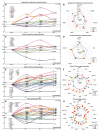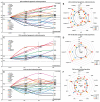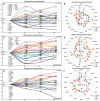Extensive protein expression changes induced by pamidronate in RAW 264.7 cells as determined by IP-HPLC
- PMID: 32509464
- PMCID: PMC7246033
- DOI: 10.7717/peerj.9202
Extensive protein expression changes induced by pamidronate in RAW 264.7 cells as determined by IP-HPLC
Abstract
Background: Bisphosphonate therapy has become a popular treatment for osteoporosis, Paget's disease, multiple myeloma, osteogenesis imperfecta, myocardial infarction, and cancer despite its serious side effects. Bisphosphonate-induced molecular signaling changes in cells are still not clearly elucidated.
Methods: As bisphosphonates are primarily engulfed by macrophages, we treated RAW 264.7 cells (a murine macrophage cell line) with pamidronate and investigated global protein expressional changes in cells by immunoprecipitation high performance liquid chromatography (IP-HPLC) using 218 antisera.
Results: Pamidronate upregulated proliferation-activating proteins associated with p53/Rb/E2F and Wnt/β-catenin pathways, but downregulated the downstream of RAS signaling, pAKT1/2/3, ERK-1, and p-ERK-1, and subsequently suppressed cMyc/MAX/MAD network. However, in situ proliferation index of pamidronate-treated RAW264.7 cells was slightly increased by 3.2% vs. non-treated controls. Pamidronate-treated cells showed increase in the expressions of histone- and DNA methylation-related proteins but decrease of protein translation-related proteins. NFkB signaling was also suppressed as indicated by the down-regulations of p38 and p-p38 and the up-regulation of mTOR, while the protein expressions related to cellular protection, HSP-70, NRF2, JNK-1, and LC3 were upregulated. Consequently, pamidronate downregulated the protein expressions related to immediate inflammation,cellular differentiation, survival, angiogenesis, and osteoclastogenesis, but upregulated PARP-1 and FAS-mediated apoptosis proteins. These observations suggest pamidronate affects global protein expressions in RAW 264.7 cells by stimulating cellular proliferation, protection, and apoptosis but suppressing immediate inflammation, differentiation, osteoclastogenesis, and angiogenesis. Accordingly, pamidronate appears to affect macrophages in several ways eliciting not only its therapeutic effects but also atypical epigenetic modification, protein translation, RAS and NFkB signalings. Therefore, our observations suggest pamidronate-induced protein expressions are dynamic, and the affected proteins should be monitored by IP-HPLC to achieve the therapeutic goals during treatment.
Keywords: Bisphosphonate; Global protein expressions; IP-HPLC; Molecular signaling; Pamidronate; RAW 264.7 cells.
© 2020 Lee et al.
Conflict of interest statement
The authors declare that they have no competing interests.
Figures









Similar articles
-
4-hexylresorcinol-induced protein expression changes in human umbilical cord vein endothelial cells as determined by immunoprecipitation high-performance liquid chromatography.PLoS One. 2020 Dec 15;15(12):e0243975. doi: 10.1371/journal.pone.0243975. eCollection 2020. PLoS One. 2020. PMID: 33320912 Free PMC article.
-
Effects of 4-Hexylresorcinol on Protein Expressions in RAW 264.7 Cells as Determined by Immunoprecipitation High Performance Liquid Chromatography.Sci Rep. 2019 Mar 4;9(1):3379. doi: 10.1038/s41598-019-38946-4. Sci Rep. 2019. PMID: 30833641 Free PMC article.
-
Pentoxifylline-induced protein expression change in RAW 264.7 cells as determined by immunoprecipitation-based high performance liquid chromatography.PLoS One. 2022 Mar 25;17(3):e0261797. doi: 10.1371/journal.pone.0261797. eCollection 2022. PLoS One. 2022. PMID: 35333871 Free PMC article.
-
Two different protein expression profiles of oral squamous cell carcinoma analyzed by immunoprecipitation high-performance liquid chromatography.World J Surg Oncol. 2017 Aug 8;15(1):151. doi: 10.1186/s12957-017-1213-5. World J Surg Oncol. 2017. PMID: 28789700 Free PMC article. Review.
-
Pamidronate. A review of its use in the management of osteolytic bone metastases, tumour-induced hypercalcaemia and Paget's disease of bone.Drugs Aging. 1998 Feb;12(2):149-68. doi: 10.2165/00002512-199812020-00007. Drugs Aging. 1998. PMID: 9509293 Review.
Cited by
-
4-hexylresorcinol-induced protein expression changes in human umbilical cord vein endothelial cells as determined by immunoprecipitation high-performance liquid chromatography.PLoS One. 2020 Dec 15;15(12):e0243975. doi: 10.1371/journal.pone.0243975. eCollection 2020. PLoS One. 2020. PMID: 33320912 Free PMC article.
-
Clinical significance of drug cessation on medication-related osteonecrosis of the jaw in patients with osteoporosis.J Korean Assoc Oral Maxillofac Surg. 2023 Apr 30;49(2):75-85. doi: 10.5125/jkaoms.2023.49.2.75. J Korean Assoc Oral Maxillofac Surg. 2023. PMID: 37114445 Free PMC article.
-
Nrf2 in the Field of Dentistry with Special Attention to NLRP3.Antioxidants (Basel). 2022 Jan 12;11(1):149. doi: 10.3390/antiox11010149. Antioxidants (Basel). 2022. PMID: 35052653 Free PMC article. Review.
-
Crosstalk Between H-Type Vascular Endothelial Cells and Macrophages: A Potential Regulator of Bone Homeostasis.J Inflamm Res. 2025 Feb 25;18:2743-2765. doi: 10.2147/JIR.S502604. eCollection 2025. J Inflamm Res. 2025. PMID: 40026304 Free PMC article. Review.
-
Significance of medication discontinuation on bisphosphonate-related jaw osteonecrosis in a rat model.Sci Rep. 2022 Dec 12;12(1):21449. doi: 10.1038/s41598-022-25347-3. Sci Rep. 2022. PMID: 36509781 Free PMC article.
References
-
- Acevedo C, Bale H, Gludovatz B, Wat A, Tang SY, Wang M, Busse B, Zimmermann EA, Schaible E, Allen MR, Burr DB, Ritchie RO. Alendronate treatment alters bone tissues at multiple structural levels in healthy canine cortical bone. Bone. 2015;81:352–363. - PubMed
-
- Akram Z, Abduljabbar T, Kellesarian SV, Abu Hassan MI, Javed F, Vohra F. Efficacy of bisphosphonate as an adjunct to nonsurgical periodontal therapy in the management of periodontal disease: a systematic review. British Journal of Clinical Pharmacology. 2017;83(3):444–454. doi: 10.1111/bcp.13147. - DOI - PMC - PubMed
LinkOut - more resources
Full Text Sources
Research Materials
Miscellaneous

